Archived Blog Posts
DIY Guide: How to Clean Up a Leaking Roof to Prevent Further Damage
6/11/2023 (Permalink)
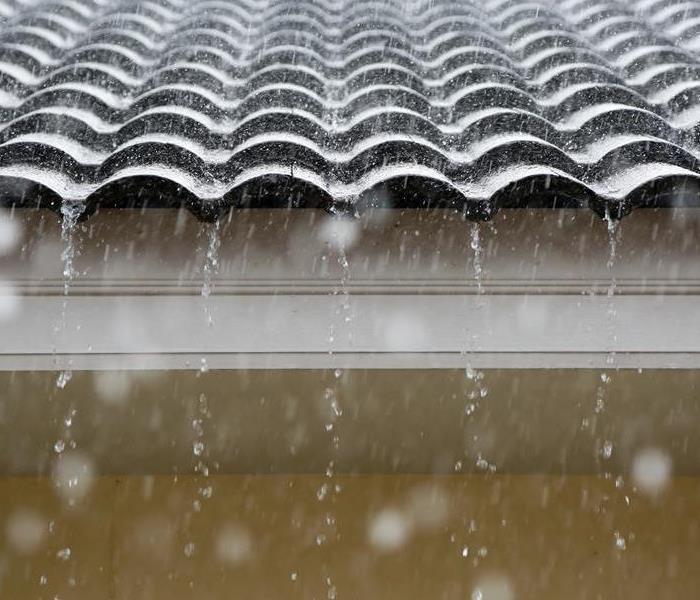 Cleaning up after a storm requires action to prevent further damage.
Cleaning up after a storm requires action to prevent further damage.
A leaking roof can cause significant damage to your home or business if left unaddressed. If you notice water stains on your ceiling or walls, it's important to take immediate action to prevent further damage. Here's a step-by-step guide on how to clean up a leaking roof.
Locate the source of the leak
Identify where the water is coming from and assess the damage. It may be necessary to climb onto the roof to locate the source of the leak. Contain the leak but placing a bucket or other container under the leak to catch any water that is dripping. If the water is spreading quickly, consider using a tarp or plastic sheeting to divert the water away from the affected area.
Remove any standing water
Use a wet/dry vacuum or towels to remove any standing water from the affected area. It's important to remove as much water as possible to prevent mold growth. Dry the area using fans or a dehumidifier to dry the affected area. This will help prevent mold growth and further damage.
Repair the roof
Once the area is dry, it's important to repair the roof to prevent future leaks. If the damage is minor, it may be possible to fix the leak yourself. However, if the damage is extensive, it's best to hire a professional roofing contractor.
Check for mold
After the area is dry, check for any signs of mold growth. If you notice mold, it's important to address it immediately to prevent health issues. Call your insurance company immediately If the damage is extensive. It's important to contact your insurance company to file a claim as soon as possible. They can help you determine what is covered and provide guidance on next steps.
It's important to note that cleaning up a leaking roof can be dangerous, especially if you need to climb onto the roof. Always prioritize your safety and use caution when addressing a leaking roof. If you're uncomfortable with the process or the damage is extensive, it's best to hire a professional roofing contractor. Additionally, taking preventative measures such as regular roof inspections and maintenance can help prevent future leaks and water damage. By being proactive and taking swift action when a leak is detected, you can help minimize the impact of a leaking roof on your property.
In conclusion, cleaning up a leaking roof requires prompt action to prevent further damage. By locating the source of the leak, containing the leak, removing any standing water, drying the area, repairing the roof, checking for mold, and contacting your insurance company if necessary, you can minimize the impact of a leaking roof on your property.
Mold Remediation Costs: What to Expect When Dealing with Mold Growth
5/23/2023 (Permalink)
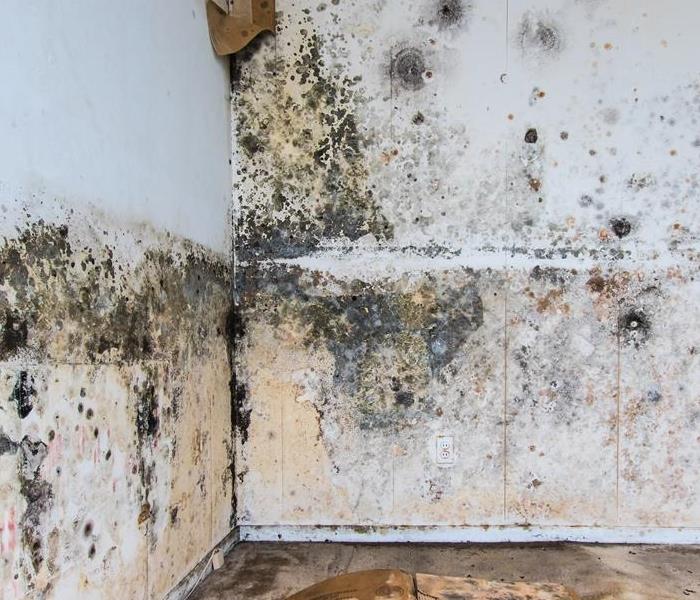 Mold remediation can be costly, hire the professionals to get the job done right the first time.
Mold remediation can be costly, hire the professionals to get the job done right the first time.
Mold remediation is the process of safely removing and mitigating mold growth in a property. If you're facing a mold issue in your home or business, you may be wondering about the cost of mold remediation. The cost of mold remediation can vary depending on several factors, including the extent of the mold growth, the size of the affected area, the location, and the type of mold present. In this blog, we'll explore the various factors that can influence the cost of mold remediation and provide some general cost estimates.
Extent of Mold Growth
The extent of mold growth is one of the main factors that can affect the cost of mold remediation. If the mold growth is limited to a small area, such as a small patch on a wall, the cost of remediation may be relatively low. However, if the mold has spread extensively throughout the property, including hidden areas such as behind walls or under floors, the cost of remediation can increase significantly.
Size of Affected Area
The size of the affected area is another factor that can impact the cost of mold remediation. The larger the area that requires remediation, the more time, labor, and materials will be needed to effectively remove the mold. As a result, larger areas of mold growth will generally be more expensive to remediate compared to smaller areas.
Location of Mold
The location of the mold can also affect the cost of remediation. If the mold is in an easily accessible area, such as a visible wall or ceiling, the remediation process may be relatively straightforward and less costly. However, if the mold is located in hard-to-reach areas, such as crawl spaces or attics, additional labor and equipment may be required, resulting in higher costs.
Type of Mold
The type of mold present can also impact the cost of remediation. Some types of mold are more common and easier to remediate, while others, such as toxic black mold, require more extensive precautions and specialized treatments, which can drive up the cost of remediation.
Additional Factors
There are also other factors that can influence the cost of mold remediation, such as the need for containment measures to prevent mold spores from spreading during the removal process, the use of specialized equipment, and the need for post-remediation testing to ensure that the mold has been effectively removed.
Cost Estimates
It's important to note that mold remediation costs can vary widely depending on the factors mentioned above and the geographic location. However, as a rough estimate, the cost of mold remediation can range from a few hundred dollars for small, localized areas of mold growth to several thousand dollars or more for extensive mold infestations that require professional remediation services.
Mold remediation costs can vary depending on the extent of mold growth, size of the affected area, location of the mold, type of mold, and other factors. It's important to get a professional assessment and quote from a qualified mold remediation specialist to accurately determine the cost of remediation for your specific situation. Keep in mind that addressing mold growth promptly and effectively is crucial to protect your property, and the cost of remediation is a worthwhile investment in ensuring a safe and mold-free environment.
Understanding Grease Fires: Causes, Prevention, and Safety Measures
4/28/2023 (Permalink)
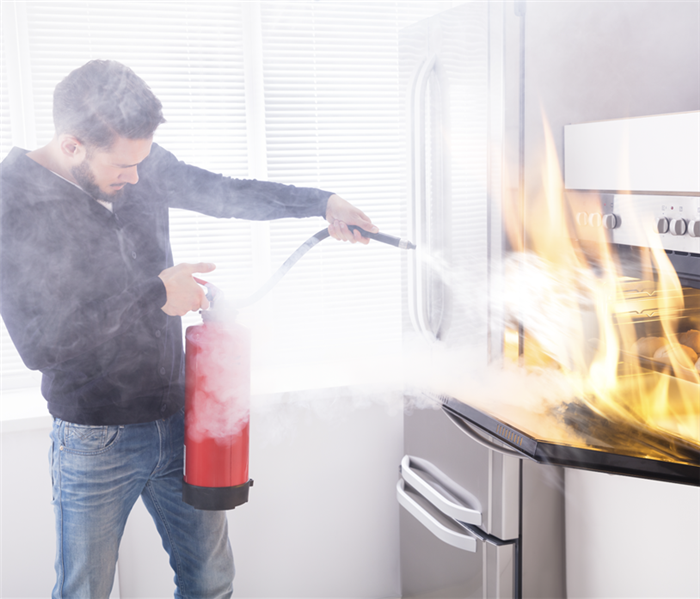 Cooking fires, including grease fires, are a serious threat to both your home and your safety.
Cooking fires, including grease fires, are a serious threat to both your home and your safety.
If you’ve ever cooked with oil or grease, you know how easily it can splatter and create a mess. But did you know that cooking oil and grease are also common causes of household fires? In fact, according to the National Fire Protection Association, cooking fires are the leading cause of home fires and injuries in the United States.
One of the most dangerous types of cooking fires is a grease fire. In this article, we’ll explore what a grease fire is, how to prevent it, and what to do if you find yourself in the midst of one.
What is a Grease Fire?
A grease fire is a type of cooking fire that occurs when oil or grease becomes too hot and ignites. This can happen when cooking oil is left on high heat for too long or when a pot of oil or grease spills onto the stove or oven. Because grease fires burn hotter and faster than other types of fires, they can be particularly dangerous and difficult to extinguish.
How to Prevent Grease Fires
The good news is that grease fires are largely preventable with a few simple steps:
Stay in the kitchen when cooking with oil or grease: This will allow you to keep an eye on the heat and prevent it from getting too high.
Use a thermometer: Knowing the temperature of your cooking oil can help you avoid overheating and prevent a fire.
Don’t leave your cooking unattended: If you need to step away from the stove or oven, turn off the heat first.
Keep flammable objects away from the stove: This includes items like oven mitts, dish towels, and paper towels.
Clean your stove and oven regularly: Built-up grease and food particles can easily catch fire if they come into contact with hot oil.
What to Do if You Have a Grease Fire
If a grease fire does occur, it’s important to know how to react quickly to prevent injury and minimize damage to your home. Here are the steps to follow:
Turn off the heat: This will stop the fire from getting bigger.
Cover the pot with a lid: This will cut off the oxygen supply and help extinguish the flames.
Use baking soda or a fire extinguisher: If the fire is too big for a lid, you can try using baking soda or a fire extinguisher to put it out.
Don’t use water: Water can cause the grease to splatter and spread the fire.
Call 911: If the fire continues to burn or you’re unable to put it out, call 911 immediately.
Cooking fires, including grease fires, are a serious threat to both your home and your safety. By following these simple tips, you can help prevent grease fires from occurring in the first place and know how to react if one does happen. Stay safe in the kitchen!
How do you know if you have a shower leak
3/20/2023 (Permalink)
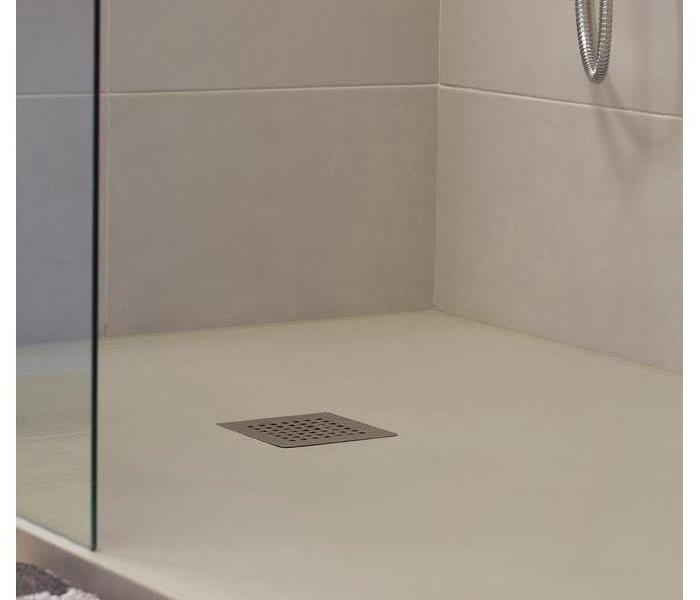 Use these tips to help prevent a shower leak, give SERVPRO a call today for your water damage.
Use these tips to help prevent a shower leak, give SERVPRO a call today for your water damage.
It's possible to have a leak in your shower that you don't even know about. You may not see any obvious signs of water damage, but behind the scenes, moisture can create mold and mildew and cause long-term damage. Here are some tips for identifying potential leaks.
Check for water stains on your ceiling.
If you see water stains on your ceiling, it's likely that a leak is present somewhere in your home. The best way to determine if a leak exists is by looking at the source of those stains carefully and seeing if any other signs of leaking have been left behind. If no leaks are found in this area, then there may be an issue with condensation. If there are signs of a leak, call a plumber immediately!
Listen for dripping water, especially at night when you're sleeping.
If you hear any dripping of water at night, especially in the middle of the night when you're sleeping, check your faucet. If it's dripping or has a leaky showerhead, fix it immediately!
If that doesn't work and you still hear dripping, check for any leaks outside your house. There could be a small hole in your roof that's allowing rainwater to enter through. If no one is home at night when this happens or even during the day, rainwater will continue to seep into places where there are gaps between shingles or boards until someone discovers it and repairs them before more damage occurs.
Look for discoloration.
If you see discoloration on walls and baseboards, it's a sign that there is water damage. If the damage is not addressed it can cause secondary damages like mold and mildew damage. This can grow on surfaces that are damp or wet for extended periods of time and cause damages in the near future.
Use a moisture meter to check for water leaks in your walls.
If you suspect that there may be a leak in your home, it's important to check for water damage. A moisture meter is an easy way to find out if there's any moisture on the inside of your walls, ceiling or basement. A moisture meter can also be used in crawl spaces and attics where it can detect water from condensation build-up on pipes or insulation materials.
While there are various types of moisture meters available today (such as digital meters), they all work essentially the same way, by measuring electrical resistance through wood or other materials that have absorbed water over time (e.g., wood framing).
These tips will help you identify if you have a leak in your shower. If you find water stains on the ceiling contact a specialist immediately to begin clean up and remediation. Give SERVPRO a call at the first sign of damage, our technicians have the experience and equipment to restore your water damage property.
5 Things You Must Do When A Pipe Bursts
1/23/2023 (Permalink)
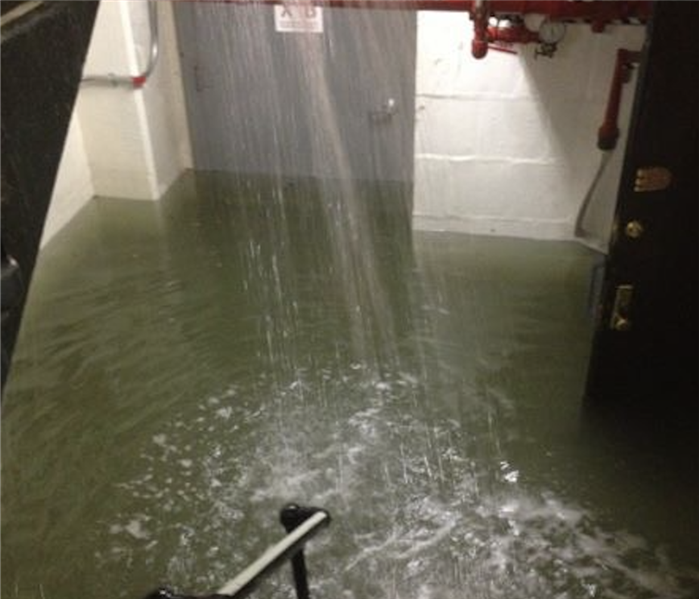 It’s important to remember that a burst pipe can cause a lot of damage, and you don’t want to be stuck cleaning up the mess on your own.
It’s important to remember that a burst pipe can cause a lot of damage, and you don’t want to be stuck cleaning up the mess on your own.
When a pipe bursts, you need to act quickly and accurately in order to avoid further damage or costly repairs. The following steps will help guide you through the process of repairing your burst pipe and restoring your home back to normal.
Step 1: Turn off the water supply.
The first step to take after a pipe burst is to shut off the water supply in your home. This prevents any more water from leaking out and causing further damage to your home or business.
Turn off the main valve in your home that controls the main water line. If you can't do this, turn off any valves close to where the pipe burst occurred. If you cannot find the water valves in your home, contact a professional immediately; they will be able to turn off both hot and cold water pipes as soon as possible.
Step 2: Turn off the power source.
Once you have turned off the water supply, turn off the power source to the entire house. If you don’t know how to turn off your home’s main breaker or fuse box, call an electrician. Doing so will prevent any damage to sockets, circuits, or breaker boxes. This can also prevent injury to people present on your property.
Step 3: Locate the burst pipe.
The next step is to locate the affected pipe. If you have been fortunate enough to witness your burst pipe firsthand, you should be able to easily locate it by looking for wet spots or stains on the floor.
If you do not see any evidence of a burst pipe and are experiencing water damage in your home, there might be one hidden somewhere. Check for signs of water coming out of a wall, ceiling, or basement/attic. Also, look out for water stains on the drywall in your home.
Step 4: Call a professional for water cleanup and restoration.
When it comes to water damage, a professional has the knowledge, expertise, and equipment necessary to restore your property. They will be able to clean up the mess and repair any damage caused by a burst pipe.
Step 5: File an insurance claim.
Next, you need to make a claim with your insurance company. Make sure you document all the damage by taking photos and gathering any other documents related to your claim. When you work with a company like SERVPRO of Highlands Ranch/NW Douglas County, they can take care of the entire claims process for you. This can be a huge relief as you are dealing with the aftermath of a pipe burst.
Breaking down the steps can help you stay calm and focused.
When dealing with an emergency like a burst pipe, it's easy to get overwhelmed by feelings of anxiety, stress, and frustration. However, if you can remain objective and follow these basic steps, your loss will be taken care of in no time.
It’s important to remember that a burst pipe can cause a lot of damage, and you don’t want to be stuck cleaning up the mess on your own. If you notice leaks or other signs of water damage in your home, contact SERVPRO professionals immediately.
Steps to Stay Prepared for Storm Damage
1/18/2023 (Permalink)
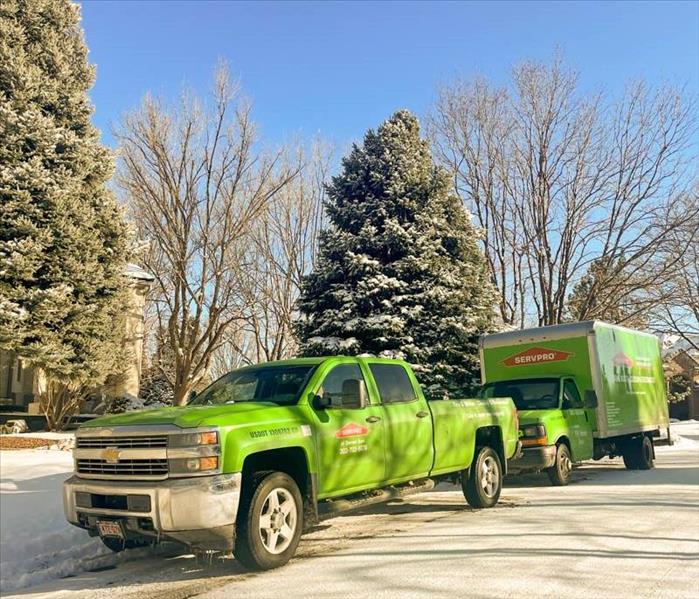 The most important thing is to be prepared.
The most important thing is to be prepared.
Storms, tornadoes, and winter storms can cause devastating damage to homes and businesses. While it's impossible to completely keep your home safe from these natural catastrophes, there are some steps you can take to prepare for storm damage. So whether you're in the path of an incoming storm or just want to be prepared for the worst, we've got some tips that'll help protect your house from Mother Nature's fury.
Prepare in advance
Prepare in advance. The best way to prepare for a hurricane, or any other natural disaster, is to have your supplies ready and organized. You should know where they are and how much of each item you have at all times.
Stock up on supplies before the storm hits. It's easy to forget that storms can last for days or even weeks, so it's important to make sure you have enough food, water, and anything else you might need during this time period.
Protect windows
One of the most important things to protect in your home is your windows. If a storm were to hit and you don't have any type of protection over them, it could cause major damage. To protect the glass from shattering, use plastic or wood sheeting and secure it around the window.
Clear yard clutter
In the days leading up to the storm, it's important to clear away any yard clutter that could be blown away by the wind. Remove any large branches that could fall on your home and clear away loose leaves and other debris from the yard. If you live in an area known for severe storms, consider hiring someone with experience removing fallen trees after a storm so that you can stay safe while performing tasks on your property.
Maintain gutters and downspouts
This is the number one way to prevent leaves, debris, and water from clogging your roof drains, which can lead to costly repairs. You should clean them regularly (at least twice a year) and make sure they are not clogged with debris. If you do notice any damage or gaps in your gutters, make sure to repair them before heavy rains come so that the problem doesn't get any worse than it already is.
Stay informed on the latest forecast
Monitor the forecast and look for any changes that might indicate a storm's path is changing, such as:
- Changes in wind speed and direction
- A shift in temperature
- Clouds or fog forming over your area
Create an evacuation plan
Even if you live in an area that is not prone to severe storms, it's still important to have a plan for evacuation. If your home does happen to be hit by inclement weather, you will be glad you had time to prepare.
The most important thing is to be prepared. Whether you’re a homeowner, renter, or business owner, it’s crucial that you take the time to protect your home from potential damage during storms. If you haven’t done so already, now is the time!
Steps to Stay Prepared For a Wildfire
12/5/2022 (Permalink)
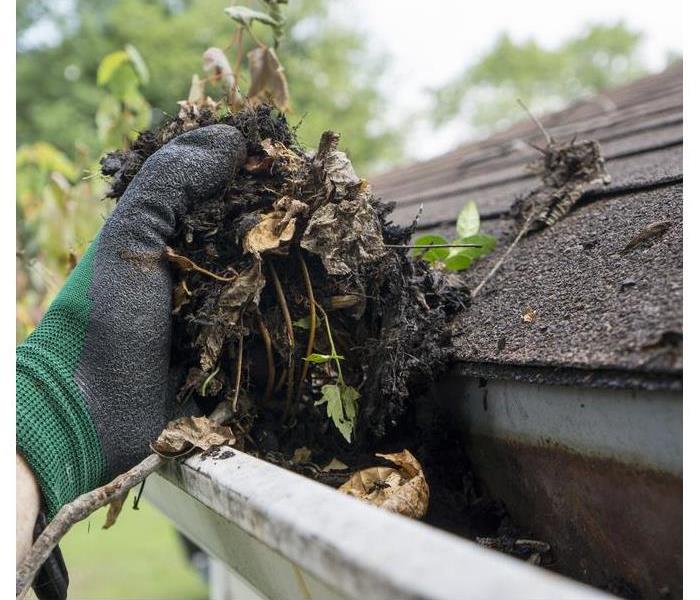 An important step to staying prepared for a wildfire is keeping your gutters clear.
An important step to staying prepared for a wildfire is keeping your gutters clear.
5 Steps to Be Prepared for a Wildfire
Wildfires are scary, but they can be prevented if you know what to do. Here are five tips from the National Fire Protection Association (NFPA) for staying prepared in case of a wildfire:
Create a defensible space.
Creating a defensible space around your home can help to keep wildfires from spreading to your property. A defensible space is an area that is free of highly combustible materials, such as dense grasses and shrubbery. It's important to create firebreaks around the perimeter of your home because it helps to protect your house and other buildings from the heat and intense flames of a wildfire.
Creating a buffer zone between this flammable material and your home makes it more difficult for fires to ignite or spread onto your property, keeping you safer in case of fire danger.
Clear your roof of any kind of debris.
Be sure to clear your roof of any kind of debris. This includes leaves, pine needles, and any other flammable material. You should also make sure that your trees are healthy and aren't close to power lines or touching your house. Finally, be sure you have a ladder that's in good condition and know how to use it safely.
Clean out your gutters.
An important step to staying prepared for a wildfire is keeping your gutters clear. The gutter is the first line of defense against wildfires, as they are designed to catch leaves and other debris before they can fall into your home. To keep gutters clear and working properly, you should clean them at least twice a year with a leaf blower or rake.
Secure the space between any wooden structures on your property.
You should also make sure that the space between your home and any wooden structures on your property, like wood fences or decks, is clear of debris. Remove leaves, branches and other debris from the area.
Remove any dead plants or trees from around your house. Remove dry grasses and weeds from beneath the eaves of your home, especially if they have grown up against windows or doors. Also keep firewood and other combustible materials away from your home.
Use a screen to prevent a fire from igniting on the ground outside your home.
If you have a wood-burning fireplace or wood stove, always use a screen to prevent a fire from igniting on the ground outside your home. Even if the screen is in place and functioning properly, there are still ways that your house can be vulnerable to catching fire.
To prevent fires from starting on your deck:
- Never leave furniture on decks when they're exposed to outdoor temperatures; make sure all combustible items are stored away safely indoors when they're off limits to human contact.
- If using propane tanks outdoors (e.g., for barbecue grills), store them in secure containers rather than leaving them out in the open.
Conclusion
If a wildfire threatens your home, don’t wait for help to come. Take action yourself. If you think about these steps before the fire arrives, you’ll be able to respond quickly and safely when it does.
5 Reasons Your Faucet Is Dripping Water and How To Fix It
11/14/2022 (Permalink)
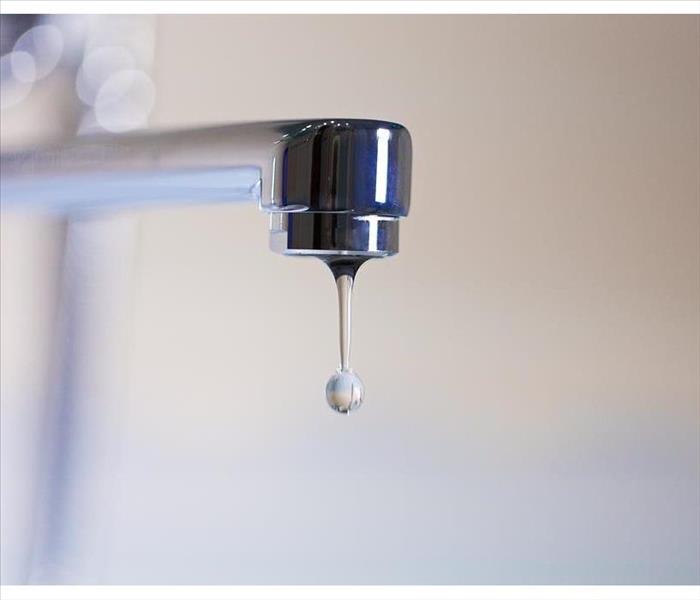 A leaking faucet can lead to a big problem.
A leaking faucet can lead to a big problem.
How To Fix a Dripping Faucet
A dripping faucet can be a nuisance, especially when it's happening in the middle of the night. If you're having a problem with a leaky faucet, this article will help explain why your sink is dripping water and what you need to do to fix it.
Reason #1: Your Washer Is Worn
You may have a leaking faucet if the washer is worn out. The washer is the part of your faucet that seals against its body and prevents water from flowing out. Over time, wear and tear can cause this seal to become loose or even break apart entirely, thus allowing water to drip at an alarming rate.
To fix this problem, first purchase a replacement washer for your particular model of faucet (you can buy them online or at any hardware store). Once you've bought it, remove all visible parts from inside the spout—this will include anything like screws or nuts—and then take off any cover plates on top of where you'll be working so that you can access everything easily without having to use tools. Next up, grab your new replacement washer and place it inside where your old one once sat; make sure both ends line up correctly before reattaching all other parts back into place again!
Reason #2: Your O-Ring Needs Replacing
If you're lucky, your dripping faucet is due to a worn-out O-ring. If this is the case, it's an easy fix. You'll need to remove the spigot from your sink and take off its parts (using pliers if necessary). You'll then need to replace the rubber ring that seals around the stem of your faucet. This can be done by buying a new O-ring at any hardware store or home improvement store and putting on a new one using tools like needle nose pliers or channel locks.
Reason #3: You Need To Replace a Cartridge in the Faucet
Cartridges are the most common cause of leaking faucets. They are easy to replace and can be replaced without removing the faucet or shutting off the water supply.
After you have located your cartridge, remove it from its housing by turning it counterclockwise until it is completely removed. Then, insert a new one into place by turning it clockwise until it stops resisting insertion (you should feel this). If you’re unsure about whether or not you have successfully inserted your new cartridge, try tightening it slightly more than finger-tight so that there aren’t any gaps between threads and housing surfaces; if there are no gaps and everything feels secure, then congratulations! The leaky condition has been fixed!
Reason #4: The Water Supply Tube Is Damaged
If you have a leak in your water supply tube, it's likely that this is the cause. The water supply tube connects your faucet to the municipal water supply. If there are any leaks or cracks in this pipe, it will result in drips coming from under your sink.
The first thing you should do when trying to locate a leaky water supply tube is to check its length and diameter. If it's too short, it could be kinked or crimped causing an improper seal around the faucet body (the part that screws into the sink).
If you think that may be causing problems with your leaky faucet consider getting a longer one (usually available at hardware stores) and replacing it with another section of pipe so as not to disturb other systems such as PEX tubing or wiring if they're located on top of each other near where these pipes connect together.
Reason #5: The Diverter Needs to Be Replaced
The diverter is a small valve located between the faucet and sink drain. The job of this valve is to divert water flow away from the sink, so it doesn't overflow. If your faucet has been dripping for several months, there's a good chance that your diverter needs to be replaced.
Replacing your diverter can be done by any handy homeowner with basic tools and some plumbing knowledge. Depending on how much wear and tear has occurred, replacing this part will cost anywhere between $15-$50 dollars depending on where you purchase it.
Sometimes it takes some investigation to figure out how to fix a leaky faucet, but there's a reason. A dripping faucet can be caused by many things: water hardness in your area, the age of your fixture and pipes, or even a small crack in the spout. Some problems are easier to fix than others—and some require professional help.
If you've ruled out all the possible reasons your faucet is leaking and it still isn't fixed, then it's probably time to call a plumber. It's not always easy to find the source of a leaky faucet, but if you follow these steps and take your time troubleshooting, you'll be able to solve most problems on your own.
Sometimes a leaky faucet can lead to a big problem. No matter how large of a water damage event you have, SERPVRO of Highlands Ranch is here to help you get your Lone Tree, CO home back to normal.
How to Use a Fire Extinguisher
10/7/2022 (Permalink)
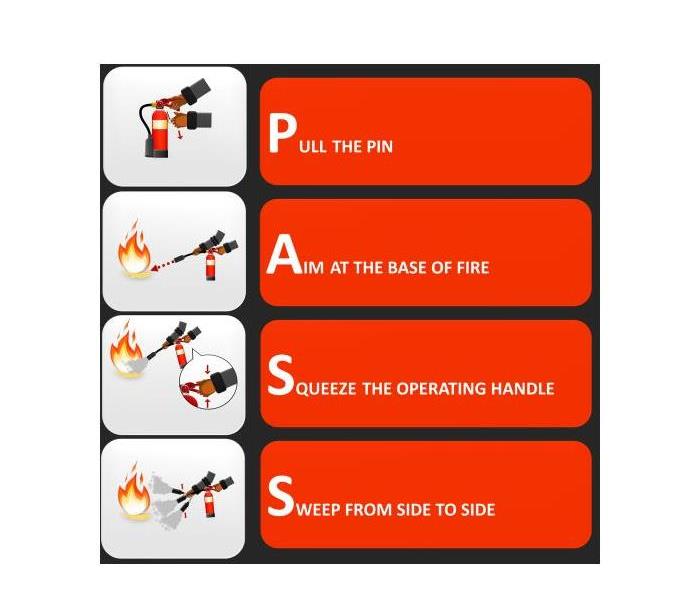 Tips on how to use a fire extinguisher
Tips on how to use a fire extinguisher
A Guide to Fire Extinguisher Use
A fire extinguisher is a great tool to have around the house. It can save you from a lot of trouble, but what happens when one has to be used? This is not as easy as it may look on television! Here are some tips on how to use a fire extinguisher.
Pull the pin out.
The first thing to do is pull the pin out of your fire extinguisher. To do this, you want to make sure that it's in the correct position and that it's pointing upwards. To ensure this, turn your head so that you can see what direction your fire extinguisher is facing. Then make sure the pin is facing up before pulling it out with your right hand.
Aim at the base of the fire.
Aim the fire extinguisher low towards the base of the fire.
Squeeze the lever slowly and evenly.
You may be tempted to squeeze the lever as hard as possible or to do it as fast as you can. But neither of these methods will produce effective results. The lever should be squeezed evenly, and not too slowly or quickly. The correct way to use a fire extinguisher is by squeezing the lever until the entire extinguishing agent is discharged from the nozzle (this may take multiple squeezes, depending on how much pressure was put into each squeeze).
Sweep from side to side.
The most common mistake made using a fire extinguisher is aiming at the base of the fire and in one spot. Sweep from side to side, aiming low—not directly into the middle.
- Do not use it on grease fires.
- Do not use it on electrical fires.
- Do not use it on chemical fires or gas fires (unless specifically labeled).
This is not as easy as it may look on TV!
There are a few things you need to know before attempting to use a fire extinguisher. First, you must be able to read the instructions on the fire extinguisher label. Second, practice using it in case of an emergency.
In order for these steps to work properly, they must be followed closely by all individuals who wish to ensure the safety of themselves and others around them during dangerous situations involving flames. If you don't follow them closely then it can cause problems such as injuries while trying out different parts of your home
A fire extinguisher can be used to smother an open flame, but it is not a good idea to use one on large blazes. Instead, call the fire department if you have time and are not in danger of being injured by the blaze. A fire extinguisher should be used only for small fires that are contained or can be easily contained by a few people. If someone is burning their dinner or has lit something on fire in their home, using an extinguisher can immediately cool down the flames enough so they do not spread throughout your house or apartment building.
If your Denver home or business catches on fire, give SERPVRO of Highlands Ranch a call for fire and water damage restoration.
What You Need To Know About Water in Light Fixtures
8/31/2022 (Permalink)
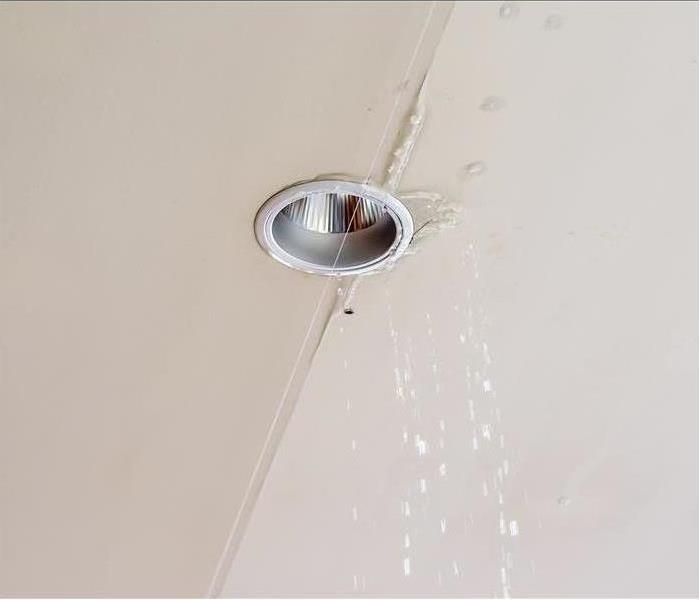 Light fixtures are the last place we expect to see water
Light fixtures are the last place we expect to see water
Information on Water in Lighting Fixtures
Light fixtures are probably the last place you'd expect to see water, but it happens more often than you would think. As a homeowner in Lone Tree, CO, you need to know the risks of water in light fixtures, what to do about it, the causes, and how to prevent it.
Risks
Risks of such leaks include:
- Electrocution
- Electrical Fires
- Ceiling damage
- Ceiling collapse
What To Do
Because dealing with water in light fixtures is so dangerous, it is always best to call an electrician for help. Use your home's breaker box to shut off electricity immediately after discovering the leak, but do not touch the light switch, water, or light fixture. Water conducts electricity, so you could be electrocuted if you come into contact with any part of the circuit.
This flooding can also cause ceiling damage. You may notice the area dripping water or sagging. This could cause your ceiling to collapse. A water damage restoration specialist should be called to repair your ceiling as quickly as possible.
Causes
The main causes are water leaking from your air conditioning unit, a leaking pipe, bad weather, and overflowing toilets or sinks. If possible, stop the source of the leak by shutting off the water supply or turning off the faucet that is causing an overflow.
Prevention
Overflowing toilets and sinks are easily preventable. Make sure to keep an eye on running water in bathtubs, showers, and sinks, so that they do not overflow. If a toilet will not flush, do not flush it again, as this can cause it to overflow. Instead, plunge the toilet to clear blockages. Replacing air filters regularly can help avoid air conditioning leaks. If you notice your ceiling leaking at all during bad weather, have it checked as soon as possible to prevent more severe leaks later on. Installing leak detection systems and avoiding harsh, chemical cleaners can prevent leaking pipes.
When you do have water in light fixtures, being aware of the risks and what to do can help keep you safe and minimize damage to your home.
These 5 Things Make Filing a Flood Claim Much Smoother
8/26/2022 (Permalink)
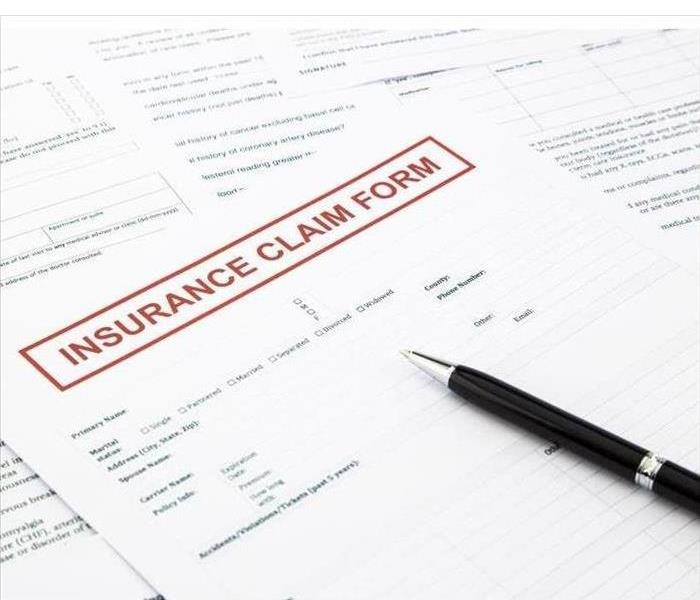 An insurance claim takes time
An insurance claim takes time
Five Ways To Prove Your Case
Are you nervous about filing a flood claim? The thought of dealing with insurance can be a bit intimidating. You want your home fixed. The insurer wants to be sure it falls under a plan. To make the situation a bit easier, it’s best to think about what the agent needs and how you can best provide that information.
1. Initiate Contact
Call immediately to start an insurance claim. The quick response shows concern and an attempt to make immediate repairs.
2. Secure the Premises
When you file a flood claim, the residence is usually uninhabitable. How are you keeping the property safe while you are out? Are broken windows boarded up? Is the roof in good condition? Make sure trespassers cannot enter and that inclement weather cannot continue to deteriorate the place.
3. Tend to Immediate Damage
An insurance claim takes time. Don’t wait to fix anything in great demand. A broken pipe or busted sewer line cannot be put off. Go ahead and get the source of trouble corrected, saving receipts to verify the repair.
4. Assess the Property
Allow professionals from several fields to complete overviews of the home. An electrician should check on wires, ensuring that everything is okay within the walls. A water restoration company in Roxborough Park, CO, should test the air and structural materials. These experts provide essential knowledge about the type and extent of contamination, putting together an action plan for appropriate cleanup.
5. Document Everything and Anything
Save all overviews and photograph anything that the water touched. Visual proof validates an appeal to seek financial compensation for personal and property loss.
Homeowners must demonstrate not only a desire to start a flood claim but also a legal and fair reason for seeking financial compensation. Remember to think about what the insurer needs, concentrating on providing an arsenal of information and a solid reason for the request.
How To Detect Mold In Air Ducts
8/10/2022 (Permalink)
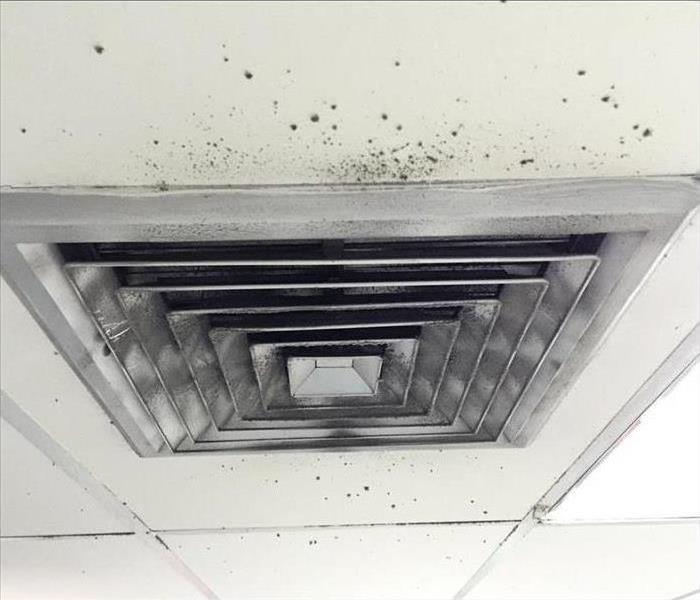 Mold present in air duct
Mold present in air duct
Mold Growth In Air Ducts
When you smell a moldy odor while running air conditioning or heating at a commercial building in Castle Rock, CO, you may need to arrange for mold testing, remediation, and HVAC cleaning. A powerful mold smell in other areas of the structure could indicate a larger problem. Ductwork transports mold spores throughout a building and leads to more extensive infestations. Find out how mold cleanup specialists identify whether mold is growing in air ducts.
Check for Visible Growth
Visible signs of mold growth may be evident in or around air vents or registers. Mold may also grow in an air conditioning unit on any of the following components:
- Drain pan
- Condensation line
- Evaporator coil
If you are not familiar with the workings of a commercial air conditioner, contact an HVAC company to determine whether the unit or air ducts require cleaning. Specialists have the equipment necessary to confirm whether mold is present.
Investigate Moldy Odors
A moldy odor is often the first indication of hidden mold. If mold is growing in ducts, this odor may be stronger while the A/C is running. A thorough property inspection may be necessary prior to HVAC cleaning. Mold spores can recontaminate a structure if the underlying problem is not resolved prior to cleaning vents.
Arrange for Mold Testing
Do-it-yourself mold tests cannot reliably determine whether mold is present in a commercial building. A professional assessment that involves gathering samples can identify which mold species are growing and inform remediation measures.
If you do not see mold in a commercial building, it may be necessary to arrange for professional mold testing. Lab analysis of air, surface or batch samples can determine which species of mold is growing in a structure in Castle Rock, CO. If you know that mold is present, consider waiting until remediation and HVAC cleaning are complete to schedule a post-remediation verification survey.
How To Safely Manage Wet Light Fixtures
7/30/2022 (Permalink)
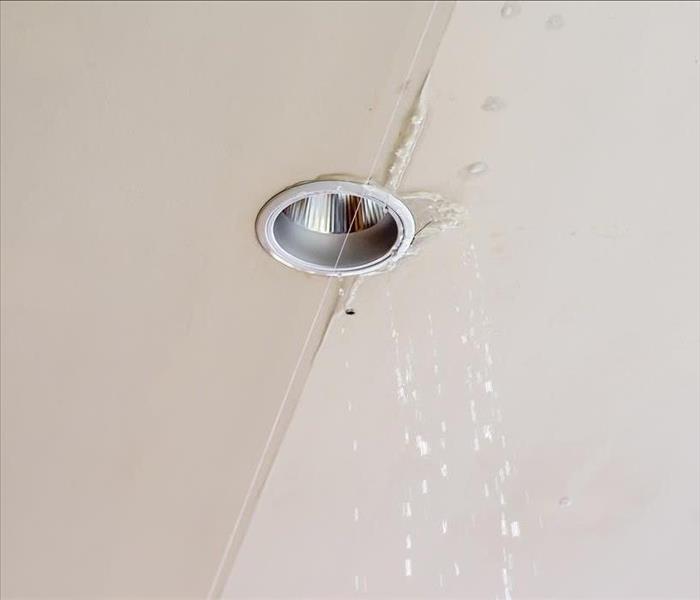 Water in light fixtures originates from somewhere in your ceiling.
Water in light fixtures originates from somewhere in your ceiling.
How To Handle Wet Lighting Fixtures Safely
Some things are made to go together, like peanut butter and jelly or cake and ice cream. However, water and electricity are unquestionably not a good match. As a homeowner in Beverly Hills, CO finding water in light fixtures is a scary and dangerous situation. How do you safely act in this situation? What happens if there is significant ceiling damage as well? Take the following actions to keep your family and your home safe.
What Immediate Actions Do I Take?
• First, stop and think before you act. Do not touch the light fixture or the switch that turns it off. Electricity must be turned off at the circuit breaker box. Confirm that the electricity is off by testing safe, dry outlets nearby.
• Unless you are a qualified electrician, do not attempt to remove the wet light fixture. Once the light is removed a new fixture should be used.
• If possible, locate the offending water source and turn off the water supply. Ceiling damage can have a number of causes such as a broken pipe, an overflowing toilet or a clogged drain.
How Do I Deal With Water Damage?
• Water in light fixtures originates from somewhere in your ceiling. Have your home inspected as soon as possible by a water restoration specialist. Without proper inspection by an expert, it is hard to know whether there is significant damage hidden from your view.
• After the inspection, the specialist makes a plan to properly dry, disinfect and restore your home to pre-water damage condition.
• Contact your insurance agent to see if water loss is covered by your policy.
When there is unexpected water in light fixtures at your home in Beverly Hills, CO remember that your safety is most important. Electricity and water are always a dangerous combination. Have the ceiling damage inspected and addressed by a reputable water restoration professional as soon as possible..
Five Types of Storm Shutters to Protect Your Home
7/24/2022 (Permalink)
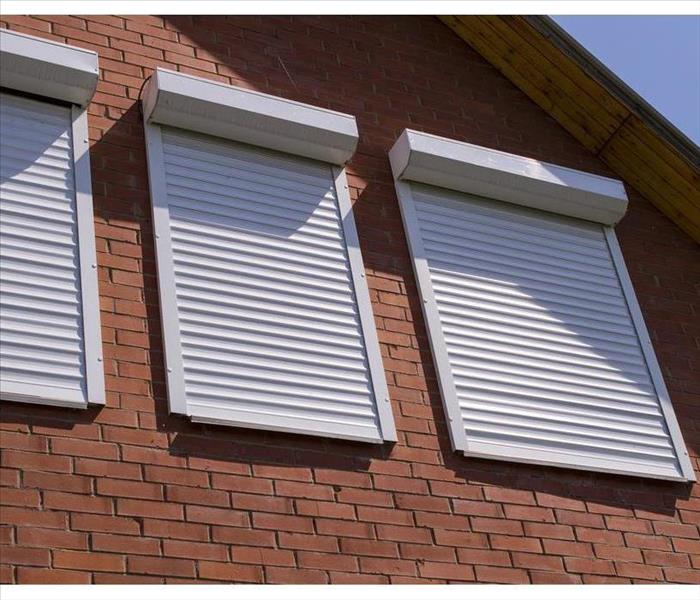 Rolling shutters are a highly effective and more permanent solution.
Rolling shutters are a highly effective and more permanent solution.
Types of Storm Shutters
If your Acequia, CO home is at risk of storm damage from high winds, you might consider some protective measures. Storm shutters are a good option, but with such variation in quality and price, where do you start? Read on to learn about some of the different choices of storm shutters for homeowners.
1. Storm Panel
Metal storm panels are to be used only when there is an imminent threat of a hurricane or severe storm. This means that for the rest of the year, your windows will be exposed. At about $7-$15 per panel, this is an extremely affordable choice for homeowners.
2. Rolling
Rolling shutters are a highly effective and more permanent solution. In addition to protection from high winds, they also offer privacy, insulation and an attractive appearance to homes. This option costs $20-$30 per square foot and is customized for every window on the house.
3. Accordion
Accordion coverings are similar to rolling shutters in that they are permanently affixed to a home in a box attached to the exterior of the building. The big difference, however, is that they are manually operated. Because of this, their price point is a little lower at $15-$25 per square foot.
4. Colonial
Colonial shutters are an aesthetically pleasing option for homes. They are similar to the decorative variety and made from metal or wood materials. They can be latched shut when a threat arrives. They come at a cost of around $200-$500 per window.
5. Bahama
Bahama awnings are permanently attached to homes with hinges. They are a great solution for warmer climates because they also provide shade. They can cost anywhere from $200-$1,000 per window.
There are many ways to protect your windows and home from the high winds and flying debris associated with hurricanes. Use your budget and personal preferences as a guide to finding the right solution for your home.
The 3 Categories of Water Damage: What You Need To Know
7/11/2022 (Permalink)
 These are the categories of water damage.
These are the categories of water damage.
The Categories of Water Damage
Water damage in Heritage Hills, CO can be devastating. Not only does your property get wet, but it may be permanently destroyed if the damage is done by contaminated water. Insurance companies categorize types of damage based on the contamination level and the extent of the water exposure. These are the categories of water damage that, as a homeowner, you need to know about.
1. Category 1
This is the type of water damage that is done by clean water, usually from sources such as a water heater, toilet tank, or supply line. This category of damage, depending on the scale, is typically the easiest to deal with. It may only require minor extraction to clean. Larger issues arise if the area was flooded for a long period of time.
2. Category 2
Category two water damage is done by slightly contaminated water commonly referred to as grey water. Sources of this type of damage include things such as broken drain pipes from sinks or leaky dishwashers. Cleaning and disinfecting may be required to repair this type of damage.
3. Category 3
This is the worst kind of water damage a homeowner can deal with. Category three includes damage done by water that has been contaminated with bacteria. This water, called black water, typically comes from things such as sewer backups, river floods, and toilet overflows. Damage done in this category may require extensive cleanup and, in some cases, major repairs.
On top of the three categories of water damage, insurance companies also classify the level of destruction from class one to class four. Class one is the lowest level of damage and class four is the largest.
Understanding the different types of water damage in Heritage Hills, CO is important if you’re a homeowner. If your property has been damaged by contaminated water, consider hiring a professional cleaning service to assist you.
What Causes a Sewage Backup in the Basement?
6/30/2022 (Permalink)
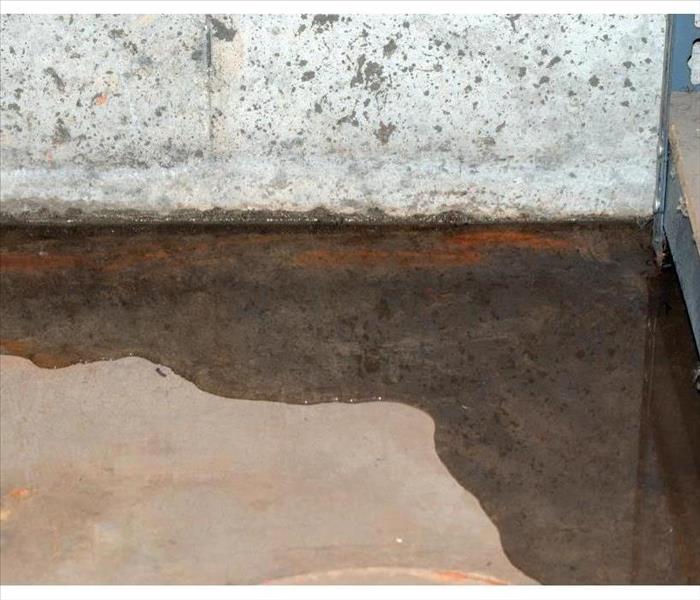 A flooded basement in Carriage Club, CO.
A flooded basement in Carriage Club, CO.
If you experience a flooded basement at your home due to a sewage backup, you may wonder what happened and what the appropriate cleanup measures may be. Fortunately, storm damage cleanup and home restoration professionals in Carriage Club, CO, can help identify the cause of the flooding and clean up affected areas.
Common Causes of Sewer Backups
The most common causes of basement flooding due to sewage backing up include the following:
- Clogs
- Bulky flushed items, such as paper towel wads
- Grease in pipes
- An aging septic system
While these culprits may most immediately come to mind, storm damage is also a frequent cause of backups.
How Storm Damage Can Lead to a Flooded Basement
If sewage lines are damaged during a particularly strong storm, it can result in problematic water flow and backups. Additionally, a prolonged period of heavy rain can be difficult for the sewage system in Carriage Club, CO, to weather, which can also lead to backups. This may cause flooded basements at individual residences during or after the storm.
How To Have Your Basement Cleaned
A flooded basement requires thorough cleaning to remove damage and restore your items. A remediation and restoration company can use a professional-grade pump to remove excess water and moisture after addressing sewage, dirt, and debris. The company will wash and disinfect areas affected by the backup and take measures to identify causes and ensure your pipes and drainage systems are in working order.
It's crucial to have your basement restored to avoid long-term damage to your items and your home. While you may be able to clean small backups on your own, it's always wise to have a professional assessment and cleaning to help prevent future issues and repeat flooding. Identifying the cause, be it aging pipes or a recent storm, also gives you the best possible chance of preventing damage in the future.
Avoid Plumbing Issues by Being Proactive
6/22/2022 (Permalink)
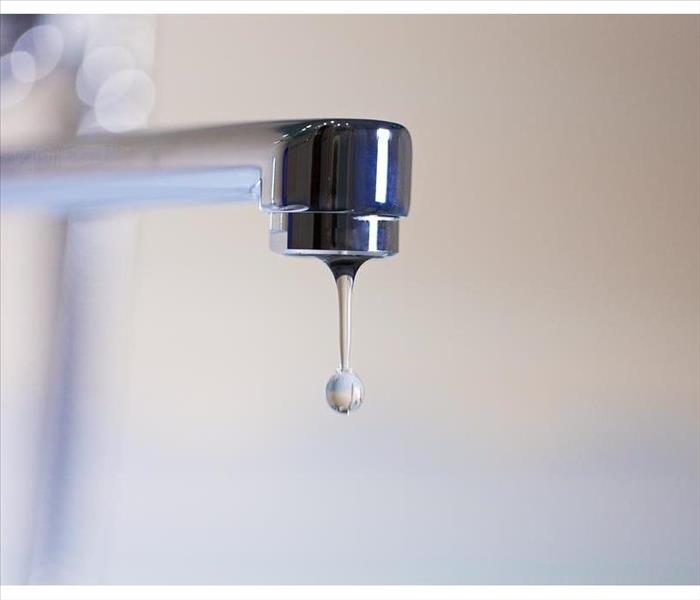 Keep an eye out for dripping taps.
Keep an eye out for dripping taps.
Be Proactive to Avoid Plumbing Issues
Plumbing is something that everyone needs but often takes for granted. It is usually only after plumbing problems are discovered that building owners get moving. Then, it could be too late to avoid water damage. The best thing to do is to remain proactive to prevent various issues with this essential system in your Roxborough Park, CO, commercial building.
1. Look for Leaks
Regularly look for small leaks around your plumbing lines, including sinks, toilets, showers, dishwashers, clothes washers, refrigerators, freezers, HVAC systems and water heaters. Also, keep an eye out for dripping taps. Any of these leaks can appear to be tiny. Still, they can quickly turn into excessive water bills and significant losses which require help from professionals, such as water damage restoration experts and plumbers.
2. Check the Toilet Flapper
A toilet flapper that is set incorrectly can result in a leak. The flapper is the arm with a weighted ball on the end that opens and shuts the inlet valve every time the toilet is flushed. It rises and falls with the water levels. This is how the water from the cistern is released to the bowl and then refilled. This is one of those plumbing problems that can result in high water bills but is typically an easy DIY repair.
3. Inspect Your Water Main
Your water main connects your building's plumbing system to the public water supply. It is usually located underground, so it's essential to know the signs of a broken pipe or other types of water main leaks. Here are just a few:
- Low water pressure
- High water bills
- Water bubbling in the street
- Water stains on drywall and/or ceilings
4. Clear Blocked Drains
You may notice a sink or bathtub emptying slower than it should. This probably means that the drain is blocked. Fortunately, this is usually an easy fix by using a drain snake.
Plumbing problems are something you hate to discover in your commercial building. However, many potential issues can be avoided by being proactive.
4 Benefits of Emergency Board Up Services
6/17/2022 (Permalink)
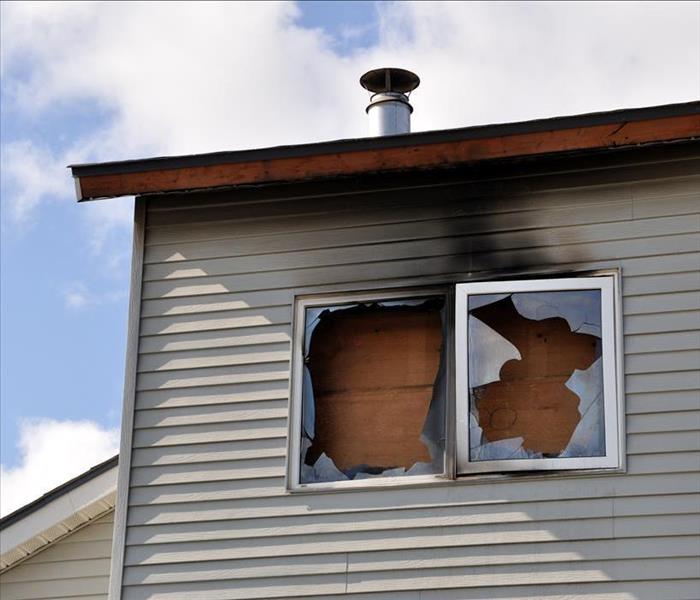 Boarding up is necessary because it prevents outside influences from damaging the home.
Boarding up is necessary because it prevents outside influences from damaging the home.
Benefits of Emergency Board Up Services
In the aftermath of a fire that has caused damage to your home, it is important to assess the damage quickly and protect your home from further harm. One way to do this is to board up any windows or doors that have been damaged. However, if you do not have experience in this area, it is a good idea to contact a professional fire restoration company in Castle Pines, CO that can ensure your home is being protected the right way.
Here are some of the main benefits of emergency board-up services.
1. Get Expert Advice and Methods
Boarding up a house that has been subjected to fire damage requires specific materials and methods. A professional can ensure that the boards are placed properly so that there are no leaks or security problems.
2. Board Up Safely
It is dangerous to interact with structures that have been damaged by fire. A professional will be able to assess the damage and proceed appropriately.
3. Prevent Further Damage
Boarding up is necessary because it prevents outside influences from damaging the home. Wind and rain can enter the house through damaged windows and doors, and animals can also cause damage. The boards keep your home safe from potential invaders and ensure that the inside of the home will be protected as you go about the restoration process.
4. Ensure Compliance With Insurance
Many homeowner's insurance plans require you to board up in order to remain eligible for the coverage. A professional service can help you protect your home quickly so that you do not lose coverage.
Emergency services are valuable because they help you go about the fire restoration process the right way. With a good plan and expert guidance, you can keep your home safe throughout the restoration process and return it to a comfortable living space as soon as possible.
How to Create a Fire Escape Plan for Your Family
5/23/2022 (Permalink)
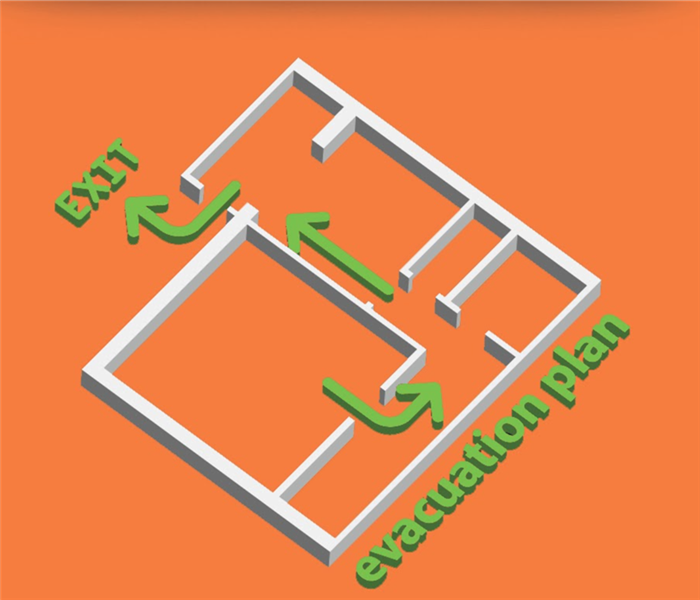 Create multiple escape routes.
Create multiple escape routes.
How to Make Your Family's Fire Escape Plan
It’s not fun to think about experiencing a fire in your Lone Tree, CO, home, particularly one large enough to require fire damage remediation, but it’s best to be ready for any kind of emergency. Creating a fire escape plan is a great way to keep your family prepared. If you’re not sure where to start, the following steps may be helpful.
1. Locate All Exits
While you likely know all of the obvious exits in your house, there may be some that you haven’t considered. Along with doors, windows on lower floors can also be a quick way to safely get out of the building.
2. Create Multiple Escape Routes
You might be used to leaving your house in a certain way every day, but if there is a fire, your usual route might not be an option. When making your fire escape plan, figure out multiple paths from each room in the house to make it easier to find your way out during an emergency. You may find it helpful, especially for younger members of the family, to post these on walls around the house.
3. Have a Designated Meetup Spot
Because you may be separated from other members of the family while leaving the building, you should agree on a location where you will meet once you make it outside. This will make it easier to determine if everyone has made it out safely. This spot should be at a safe distance from the house and should be easy for everyone to remember.
4. Practice Regularly
It does no good to create an emergency escape plan unless you practice. In most cases, practicing once a year should be enough. If you have younger children in your family, you may want to have practice fire drills more often. Knowing exactly what to do during a fire can help make the experience less stressful if it occurs.
Having a fire escape plan and making sure your family knows what to do during a fire can help keep everyone safe. Practicing often will reduce the chances of panicking during an emergency.
Mold Removal Safety Measures
5/21/2022 (Permalink)
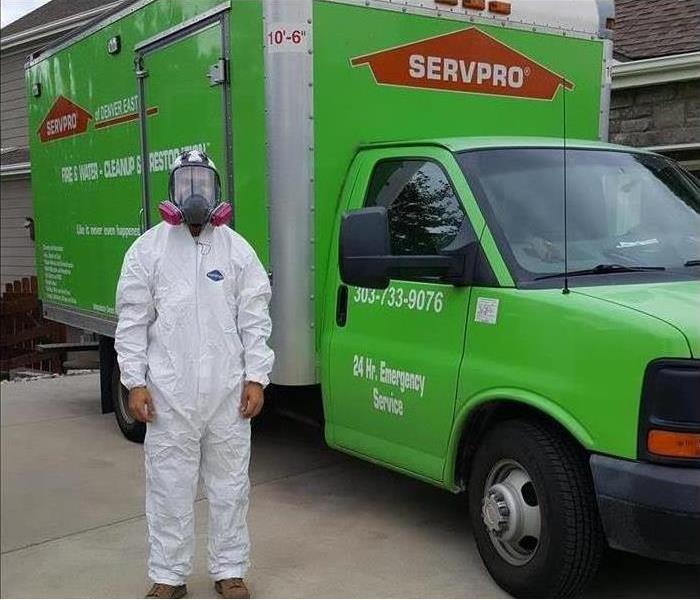 Our technicians wear protective gear when performing a mold job.
Our technicians wear protective gear when performing a mold job.
What Safety Measures Are Needed During Mold Removal?
When a qualified restoration company is dealing with mold growth, it will take several safety measures to reduce the spread of spores. In general, the size of the contaminated area will determine exactly what safety measures are needed. However, some mold remediation professionals decide more or fewer precautions are necessary depending on other factors. For instance, heavy growth in a small area may warrant more methods to reduce spreading spores. The major safety measures include Personal Protective Equipment (PPE) and containment.
Personal Protective Equipment
Employees wear PPE to protect themselves from exposure to spores. This is because the restoration process will cause spores and other debris to become airborne, making them easier to inhale. Some actions that high levels of PPE include:
- Breaking contaminated drywall
- Using invasive techniques in walls
- Removing wallpaper
- Running fans
Limited Containment
Limited containment is when one sheet of polyethylene is used to block off a contaminated area. The plastic sheets are secured to the floor and ceiling with duct tape. Workers will leave a slit in the plastic so they can enter and exit the site. This is typically used for workspaces that are less than 100 square feet.
Full Containment
Full containment involves placing double layers of polyethylene sheets between the moldy and uncontaminated areas. This also involves creating a decontamination chamber where employees suit up and remove moldy PPE. This room must be big enough to hold all of the employees' PPE from their respirators to Tyvek suits. It must also contain a hamper where dirty PPE can be placed. The doors to this entryway are thick flaps designed to protect people working in areas without mold.
This practice is used when more than 100 square feet of your building in Highland Ranch, CO, is contaminated. It may also be implemented if there is a higher risk that the spores could spread to other building areas.
When performing mold removal, there are several measures that professionals will take to protect themselves and the rest of the building. The most common methods include wearing PPE and containment.
How To Deal With a Fire-Damaged Roof
5/16/2022 (Permalink)
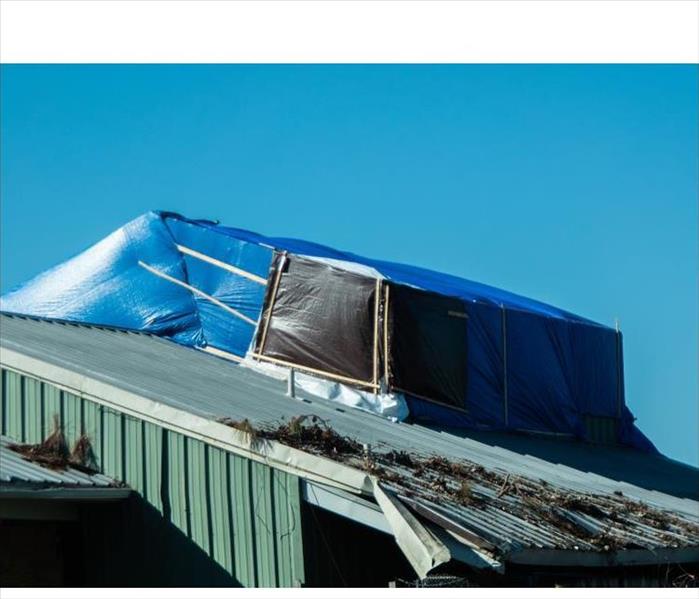 If your roof has holes you can protect it with a tarp.
If your roof has holes you can protect it with a tarp.
Four Ways To Protect Your Business Building After a Fire
Even a minor commercial fire can result in an expensive, time-consuming fire cleanup process. This is especially true if firefighters cut holes in the roof or walls during their efforts. When the fire is out and the fire department says it's safe to enter, you will want to salvage whatever is left. Follow these four steps to protect your business building after a fire has damaged your roof.
1. Notify Your Insurer
Get the ball rolling quickly on an insurance claim. Call your insurer and ask about what to do next after the fire. Covering the cost of cleanup and getting your business back on its feet is the reason you pay premiums in the first place. Your insurance company can also provide you with a list of qualified cleanup and recovery professionals in Castle Rock, CO.
2. Remove What You Can
Smoke and soot damage may be an issue even with a small fire. Inspect the building carefully to see what can be cleaned or repaired. Take the salvageable business property like the furniture to storage or another off-site location while fire cleanup is ongoing. Computers and similar hardware might be damaged beyond repair, even if the outside looks OK.
3. Protect the Roof With a Tarp
Holes in the roof can allow rain and animals into the structure, adding to any existing damage and cleanup expenses. Trespassers can also enter through any holes punched by the fire department. Until a full roof repair is possible, a tarp is a temporary practical solution. Emergency tarp services in Castle Rock, CO, can help limit further damage, allowing you to focus on the interior repair process.
4. Contact Restoration Professionals
The challenging work of cleanup and restoration after a commercial fire is best handled by professionals. These companies have the tools and experience to save as much property as possible.
When a roof is damaged by fire, a sturdy tarp keeps the elements out until a complete roof repair is possible. Fire cleanup and restoration service providers can then help get your business back on its feet quickly.
Choosing a Large Loss Response Company
4/26/2022 (Permalink)
 Our team is ready to respond at any time!
Our team is ready to respond at any time!
Choosing a Large Loss Response Company
If your business experiences catastrophic loss, you need to choose the right company to handle the situation. There are a few things that you need to look for when deciding on a company. Here are some different things to look for when choosing a large loss response company.
Look for a Company That Can Handle the Job
Catastrophic loss requires the best disaster restoration company in Beverly Hills, CO. Only top-notch professionals can respond to the largest losses. These companies have special supervisors trained to handle the operation, ensure seamless communication, and keep the mitigation on track. These companies also have trained technicians who specialize in different areas of commercial restoration. By putting together a team like this, you will be in professional hands and have fewer unexpected costs associated with a smaller company trying to perform this work. Some businesses that should look for a larger company include:
- Hospitality businesses
- Apartments or other commercial properties
- Universities
- Government buildings
Check Out Their Past Clients
Whether you are dealing with hurricanes, tornadoes, blizzards, or flooding, it is crucial to make sure the company you choose has experience. Once you find a company that can handle a large loss situation, you need to research them. Check out the company's background in the industry. Look at their past clients and see if any compare to the size of your company. Also, make sure some catastrophic loss situations match yours. Whether you have wildfires, hurricanes, floods, or blizzards, look for a comparable situation so that you know they have the experience necessary to handle your disaster.
When dealing with storm damage and large losses in a commercial setting, it is important to find a restoration company that can handle your situation. To find the right company, look for one with experience with your type and size of disaster, so you know they have the relevant experience necessary to get the job done.
Can I Claim Commercial Property Losses on My Taxes?
4/16/2022 (Permalink)
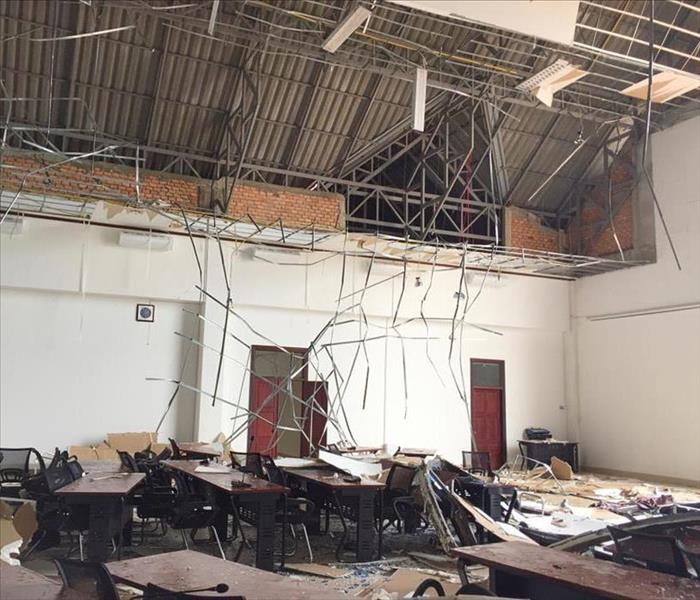 Commercial storm damage in Acequia, CO.
Commercial storm damage in Acequia, CO.
Can I deduct Losses from Commercial Property On My Taxes?
Unexpected commercial property losses have the potential to be devastating financially, mentally and time-wise. They can massively derail operations and cause a great deal of hassle. Even if you have coverage, it can be a big headache to deal with the insurance adjusters, filling out paperwork, contacting a professional cleanup and restoration service in Acequia, CO, and/or handling anything else that needs to be done in the wake of an incident resulting in one. One thing you may be glad to know is that storm damage, fire damage and other business-related losses are tax-deductible regardless of whether they are in a federally declared disaster area or not.
Casualty Losses
These include damage, loss or destruction arising from any kind of unexpected or sudden incident like a natural disaster (storm damage, smoke damage and etcetera). Normal wear and tear or time-related deterioration are not casualty losses. The three kinds (labeled as federally declared disasters) are:
- Qualified disaster losses
- Federal casualty losses
- Disaster losses
Since it involves income-producing property, your loss amount is the adjusted basis of said structure/possession (your cost, with deductions and additions for things like depreciation or renovations).
Theft Losses
If someone steals from your business, the theft loss is also the adjusted basis. If it is due to a Ponzi scheme, the rules may be slightly different.
Tax Claims Facts
Any expected or received payout from insurance companies or salvage value lowers your loss amount. You must prove any loss you claim, so detailed documentation is important. You also run the risk of acquiring capital gain if you end up with insurance reimbursement that is higher than your adjusted basis.
Storm damage and other forms of harm to your enterprise's property from events like hurricanes are tax-deductible. Theft is as well. It pays to be careful when claiming them on tax forms, especially if you do not know how much your indemnity policy will pay out as it can lead to you owing taxes on a gain instead of gaining a deduction for a loss.
4 Ways to Prevent Mold Growth in Humid Conditions
4/11/2022 (Permalink)
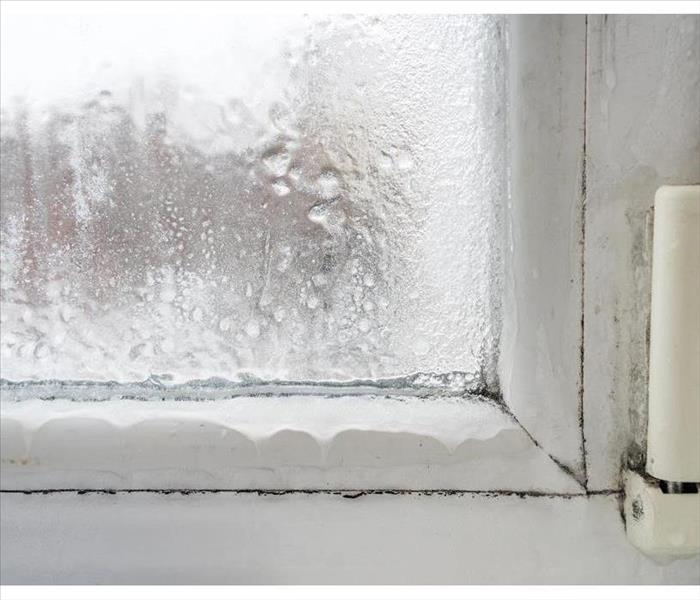 Check for condensation.
Check for condensation.
Prevent Mold Growth in Humid Conditions
Property owners in Carriage Club, CO, know that high humidity is a given. They also know that mold loves the excess moisture it produces. While it can be a challenge to prevent its growth, taking a few preventive measures may help you avoid needing mold clean up services by mold remediation and restoration specialist
1. Maintain Optimal Temperatures
Going from hot, smoldering days to cool evenings makes it difficult to avoid mold damage. Maintaining an ideal temperature is an easy way to avoid that. When the thermometer rises, ensure the air conditioner is set to 70 degrees. It is also vital to keep indoor humidity levels below 60%. Consider running a dehumidifier on days when the A/C has a tough time keeping up. If the humidity levels outside are lower, letting some fresh air helps enhance airflow and ventilate the property.
2. Check for Condensation
While you may be focused on the high humidity outdoors, there is a good chance there are appliances or fixtures that are prone to condensation, such as windows, pipes, walls and HVAC systems. Ensuring they are properly insulated is necessary to minimize any moisture buildup. It is also important to regularly inspect appliances for leaks.
3. Minimize Moisture Coming Inside
Maintaining a dry indoor environment means staying on top of minimizing outdoor precipitation from making its way in. Regularly inspect gutters and downspouts for debris or damage to ensure the system is draining properly. To minimize a basement getting a slow leak, verify that the grading is sloping away from the property.
4. Consider Using Mold-Resistant Materials
If the battle seems to be ongoing, it may be time to reinforce the property with newer materials. There are various mold- or water-resistant products available. From primers to wallboards and drywall, replacing porous materials may be an upfront investment, but they may provide much-needed peace of mind.
Knowing that high humidity is a constant, taking a few measures to guard against can go a long way.
General Liability Insurance and Mold Issues
3/31/2022 (Permalink)
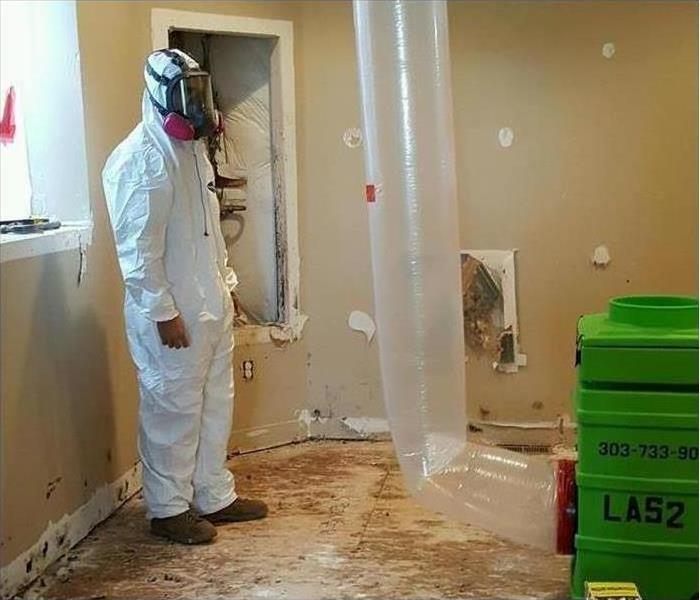 Mold remediation in Heritage Hills, CO.
Mold remediation in Heritage Hills, CO.
Mold Concerns and General Liability Insurance
Mold is a fungus that exists just about everywhere. If you own a building in Heritage Hills, CO, more than likely it contains trace levels of many different types of mold. Usually, this isn't a problem, but when moisture and warmth come into play, the mold can grow into unsightly colonies. Mold can damage materials if left for too long, and it can even cause health irritations for certain people. Mold insurance claims could be brought against your company for both property damage and for liability issues. To understand the extent of your coverage, you should speak with your insurance provider.
General Liability and Mold
Your commercial insurance covers you for many situations related to a mold claim. If you are sued, your insurance company should come to your defense. It might even provide some level of reimbursement if you are hit with an adverse judgment. However, coverage against mold insurance claims is not absolute, and could be nullified under certain conditions:
- Neglect
- Malice
- Incompetence
In other words, you must do what is reasonable to address mold in your buildings in a timely manner. Also, if complaints about mold have been ignored, your insurance company could have a reduced responsibility to defend you against lawsuits.
Mold Remediation
While mold can be difficult for an ordinary cleaning company, a mold mitigation franchise is experienced in treating mold outbreaks. The workers have the certifications and the equipment needed to restore a building to its pre-mold state. They do this by limiting the spread of microscopic mold spores, killing the fungus with powerful cleaning agents, vacuuming up the mold residue and disinfecting the impacted surfaces. A professional mold restoration treats all aspects of a mold outbreak and makes sure that another fungal outbreak will not occur. It reduces the chance of any health issues affecting your tenants, and it also reduces mold insurance claims for liability matters.
How To Check Your Home for Damage After a Late Winter Storm: 3 Steps
3/29/2022 (Permalink)
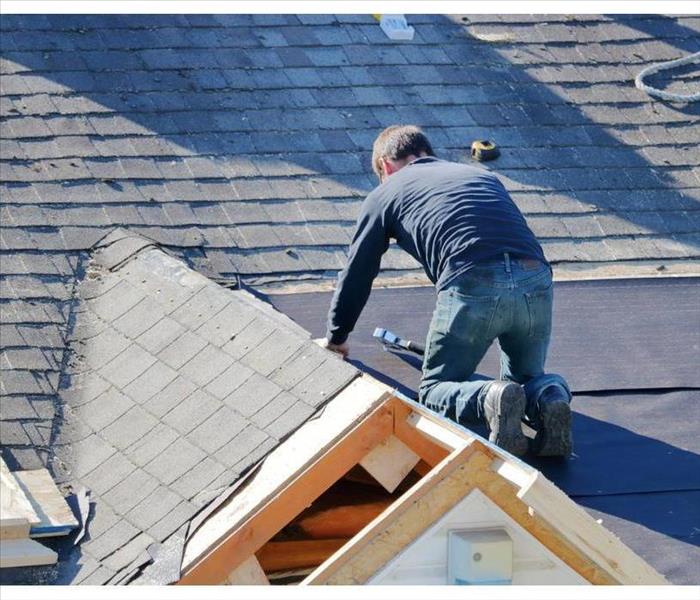 Check your roof in case you have missing shingles.
Check your roof in case you have missing shingles.
How to Assess Damage to Your Home Following a Late-Winter Storm
The arrival of March in Castle Pines, CO, may bring many things, including a late winter storm. These events can crop up quickly and cause considerable damage to your home, especially if a previous warmup had you preparing it for spring weather. If a late storm brought snow, ice and wind to your area, there are a few steps you can take to check your home for damage.
1. Inspect Your Pipes
Freezing temperatures and blizzard conditions can affect your home’s plumbing pipes, especially if they are not protected. After the storm has passed, check all your outdoor pipes and insulate them by wrapping their lengths in cotton rags or with a spray-on foam. Indoor pipes that run along exterior walls may also be at risk for freezing or bursting, so it is wise to check these as well.
2. Check Your Roof
High winds and heavy snow can cause serious roof damage, so you may want to check for missing tiles, exposed flashing and bent or hanging gutters. While the weather may not allow you to access your roof right away, you can check for leaks via your attic. If heavy snow is causing sagging in any areas, you might want to call your contractor right away to prevent collapse, something that could be dangerous and costly to fix as well.
3. Be Aware of Basement Flooding
A winter storm could be followed by lots of sunshine, which leads to a quick thaw. This could cause basement flooding, so check your sump pump and move stored belongings to higher ground for their safety. A flood damage and storm response service may be able to assist you if your sump pump is not operating properly and you are concerned about an imminent flooding event.
When a late winter storm impacts your Castle Pines, CO, home, you may be unsure about what kind of damage may have occurred. Knowing where to look in the aftermath can keep your family and property safe until bad weather passes.
A Landlord’s Guide to an Apartment Fire
3/24/2022 (Permalink)
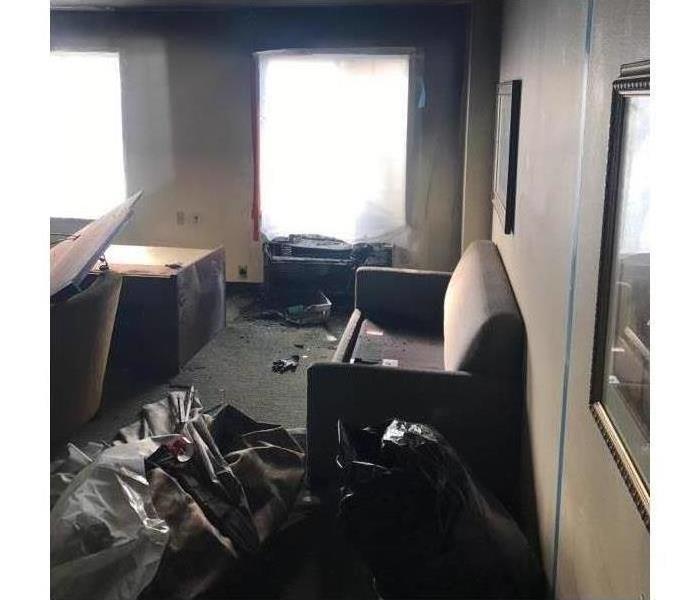 Apartment damaged by fire in Highland Ranch, CO.
Apartment damaged by fire in Highland Ranch, CO.
Rebuilding After Your Apartment Fire
A fire in your Highland Ranch, CO, apartment building is an event that causes panic and confusion for you as well as tenants. There are many questions about rebuilding and who is responsible for the losses and cost of cleanup. The following steps will help guide you through the process of rebuilding after your apartment fire.
1. Contact Your Insurance Company
The immediate first step to take is to call your insurance company. You need to file a claim and get details about exactly what your policy covers. You will likely be dealing with upset tenants, some who may not have renter’s insurance, and they will have questions about whether your insurance covers fire damage related to their property. Unfortunately, a landlord’s insurance policy won’t cover tenant possessions, so they should be directed to contact their own insurance agent or the Red Cross, if needed.
2. Obtain Detailed Information on Fire Cause
Stay in contact with the fire department or investigators, and interview all tenants. The cause of the apartment fire is important for insurance purposes, possible criminal prosecution and preventing future problems. If you find any new information related to its cause, contact the fire investigator and your insurance agent immediately. If a tenant has directly caused the fire, your insurance company will be able to work with you to obtain payment from that resident.
3. Call a Restoration Company
It’s important to contact a competent fire restoration company. They will know the best way to salvage items, limit further damage and contact companies who can start rebuilding quickly. They also can help you navigate the insurance company and its role in paying for repairs. It’s important to contact professionals, as fire causes damage to a building’s structure and is a huge liability if not repaired correctly.
An apartment fire is an unforeseen event that can seem overwhelming. However, if you contact your insurance company and a professional fire restoration team, they will help you manage the process and rebuild. It will leave your Highland Ranch, CO, property “Like it Never Even Happened”.
The Different Levels of Contaminated Water
2/25/2022 (Permalink)
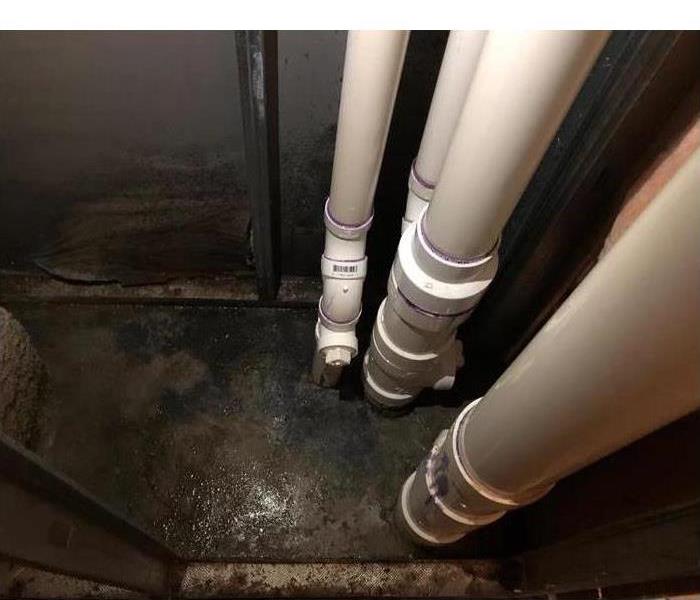 A water leak can cause mold growth.
A water leak can cause mold growth.
Water Damage Categories
Not all water is the same, and when you have a flood in your home, you want to leave it to the professionals to deal with contaminated water of any kind. Some flood water in Roxborough Park, CO can be relatively clean while some homeowners have to contend with black water at one point or another. Any kind of water can lead to mold growth, so address your precise situation as best you can.
1. Category 1
Category 1 water is typically clean, but it may contain contaminants from the surrounding area. This type of water usually comes from a faulty supply line on an appliance or a broken water pipe. When the water leaks out into a room, it may pick up soil or materials from the surrounding area, such as materials from the subflooring, decking or walls. However, if it is accidentally consumed, then it should not result in any serious illness.
2. Category 2
Category 2 contaminated water is slightly more dangerous. In the event a person accidentally consumes it, then it would likely result in some discomfort or sickness. This level can also be called grey water, which can include water that comes from sink drains or washing machines.
3. Category 3
Category 3 flood water is the most dangerous and most commonly referred to as black water. This water typically contains fecal matter and can come from a toilet overflow. It can also come from rainwater picking up contaminants from the outside soil and bringing them inside your home in Roxborough Park, CO. Additionally, standing water can promote bacterial growth.
Allowing water to stand in a room can cause less dangerous contaminated water to grow worse by the second. Fungi just need stagnant air, a moderate temperature and moisture to grow. This is why it is so critical to remedy the situation as soon as you can.
What Should Be Thrown Away After a Fire?
2/14/2022 (Permalink)
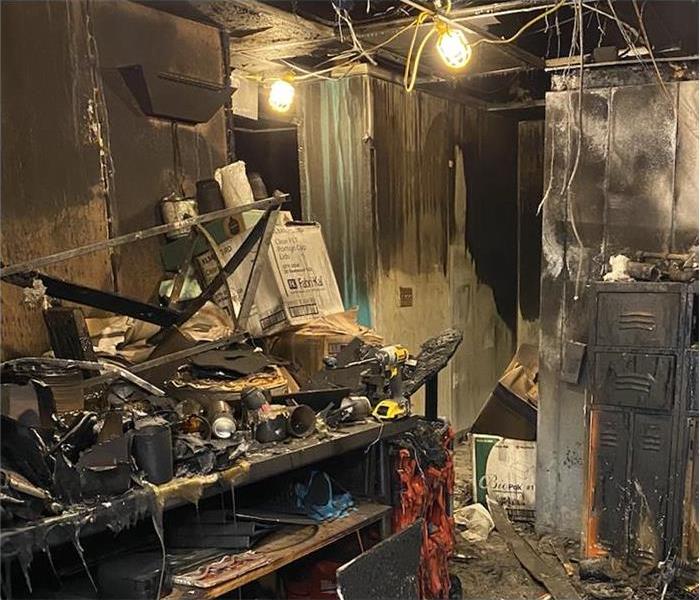 Severe fire damage in Lone Tree, CO
Severe fire damage in Lone Tree, CO
After a Fire, What Should Be Thrown Away?
When it comes to a house fire, a lot of people only think about the charring and destruction caused by flames. Even small fires that don’t completely destroy your home in Lone Tree, CO, can cause a lot of damage from smoke alone. It’s hard to know what you can keep and what you should throw away when your belongings have been exposed to:
So, what should you throw away after a fire? That really comes down to your personal safety, which can be divided into two categories: things you eat and things you put on your body.
Things You Eat
You may think that food and drink would be safe to consume if it remained sealed during a fire, but smoke can permeate packaging, and heat can alter the contents inside the package. You don’t want to risk putting anything in your body if it was near a fire, heat or smoke. That includes:
Sometimes, food in the refrigerator is spared from the smoke and high heat, but remember to make sure the food wasn’t sitting for more than two hours at a temperature of 40 degrees or more. If it was, throw it out!
Things You Use on Your Body
There are many products people use that may have an impact through body contact or absorption. Here are some things you should throw away if they were exposed to heat, smoke, soot or fire.
Charred clothing should be thrown out since it would come in contact with your skin, but you may be able to salvage some smoke-damaged clothing through washing or dry-cleaning.
When you have fire damage in your home, you can get help from fire restoration experts that will guide you through the cleanup and restoration process. Make sure you use extreme caution and throw out the items highlighted here if they have been exposed to smoke, soot, heat or water from the firefight.
Three Tips for Maintaining Your Business’s Exterior
2/1/2022 (Permalink)
 Keeping your building maintained is an important part of storm preparation.
Keeping your building maintained is an important part of storm preparation.
Storm Preparation
If you are expecting bad weather in Castle Rock, CO, it is a good idea to check your business’s building for anything that might create more damage during a storm. Even if there are not any bad storms in the forecast, proper exterior maintenance is important and should be done regularly. When you are inspecting the outside of your building, keep these things in mind.
1. Locate Vulnerable Areas
Some areas of your building are more likely to suffer damage than others. You should be sure to check these areas closely. Windows, in particular, should be examined carefully during a building inspection. The weather stripping and insulation might deteriorate more quickly than sturdier parts of the building, so you should make sure that all of the seals are functioning properly and will not let in cold air and water.
2. Check for Problems
You should perform exterior maintenance regularly to check for any problems in the walls of your building. Make sure that there are no gaps or cracks in the walls or cladding that could let in air or water as even a small amount of liquid could cause a lot of damage, particularly if mold were to start growing in the walls. Be sure to check the thickness of any paints and coatings as well.
3. Hire a Professional
In order to make sure that everything is as it should be, you should have exterior maintenance done regularly by a damage restoration specialist. It is good to examine the building on your own between inspections with a professional, but there might be issues that you don’t recognize. A professional will be able to find any problems that you might have overlooked.
Keeping your building maintained is an important part of storm preparation and should be done regularly to keep everything in top shape. It is a simple way to prevent damage during storms and bad weather.
Contaminated Water Removal Requires Professional Training and Tools
1/28/2022 (Permalink)
 Restoration companies categorize water into three groups.
Restoration companies categorize water into three groups.
Flooding poses many problems for Beverly Hills, CO, homeowners beyond the obvious cleanup requirements. Contaminated water, black water and clean water from an uncontaminated supply line are all part of the puzzle, and each has special requirements in the restoration process. One of the first steps a restoration company takes is determining what type of water is making a mess of your home.
3 Categories of Water
Restoration companies categorize water into three groups:
• Category 1: This is water that is safe to drink. Known as “clean water,” it is provided through a sanitary source, such as drinking fountains and faucets. Water in your toilet tank and water heater is also considered clean.
• Category 2: Water in this category is “gray water.” It contains contaminants that can make you sick if you drink it. Gray water can come from an overflowing clothes washer or dishwasher, or may be water flushed from sink drains. It can even be water from an overflowing toilet that may contain urine, but not feces.
• Category 3: This is the worst type of contaminated water. This type of water comes from sewer backup or overflow with feces, along with floodwaters from rivers or streams.
Making Restoration Plans
A sink or tub overflow involves clean water, which has no special handling or disposal requirements. Depending on the severity of the overflow, you may be able to salvage flooring, carpeting, baseboards and furniture, as well as drywall.
Contaminated water, including both gray and black water, should be handled by restoration professionals. It requires special training and tools to assess both the water and water damage and to develop a restoration plan for your Beverly Hills, CO, home. If you are unsure whether your water supply line has been compromised, be sure to boil your water until supply system operators tell you it’s safe to use.
How Can Homeowners Assess Mold Damage?
1/28/2022 (Permalink)
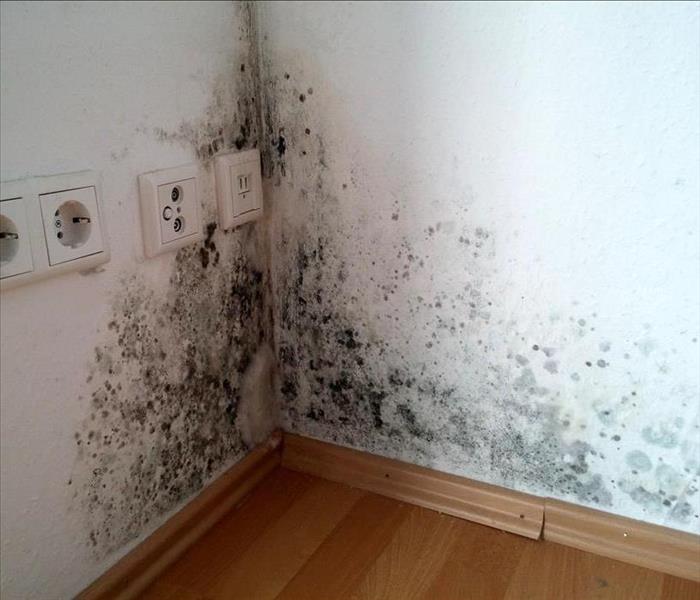 A musty odor may indicate the presence of hidden mold.
A musty odor may indicate the presence of hidden mold.
What Is the Best Way for Homeowners to Evaluate Mold Damage?
A complete mold assessment involves determining the type of mold and extent of growth. Accurate analysis can be difficult and risky for non-professionals. Here are a few measures homeowners can take in preparation for an expert assessment.
Look for Visible Mold
Homeowners can look for signs of visible mold. Do not attempt to find mold hidden in places where colonies may be disturbed by a search:
- Behind wallpaper
- In wall cavities
- Under carpet
A musty odor may indicate the presence of hidden mold. This odor originates with microbial volatile organic compounds, which are off-gases released during the fungal growth cycle.
Schedule Testing
An environmental hygienist or mold specialist can contribute to an accurate mold assessment. Experts may take air or spore samples for lab analysis to determine which types of mold are present, such as black mold or more than 100,000 other species.
Identify the Cause
Mold and mildew thrive where moisture is present. A homeowner can try to identify the source, which may involve one or more of the following factors:
- Leaky pipes
- A roof leak
- Other water damage
Mold is a common type of secondary damage that results when water damage is not properly mitigated. It is important to remove standing water and residual moisture to prevent fungi from starting to grow.
Determine the Extent
Mold remediation experts can determine the extent of an infestation. A minor mold problem covers less than 10 square feet and is accessible without opening large sections of closed surfaces. Major problems affect larger areas and may involve hidden mold or black mold.
Minor mold growth can cost over $1,000 to remediate, while major damage can range up to tens of thousands of dollars. A mold assessment may impact a homeowner's ability to file an insurance claim or pay for remediation that will resolve a mold problem at a residence in Castle Rock, CO.
3 Important Steps To Take After a Fire Affects Your Business
1/4/2022 (Permalink)
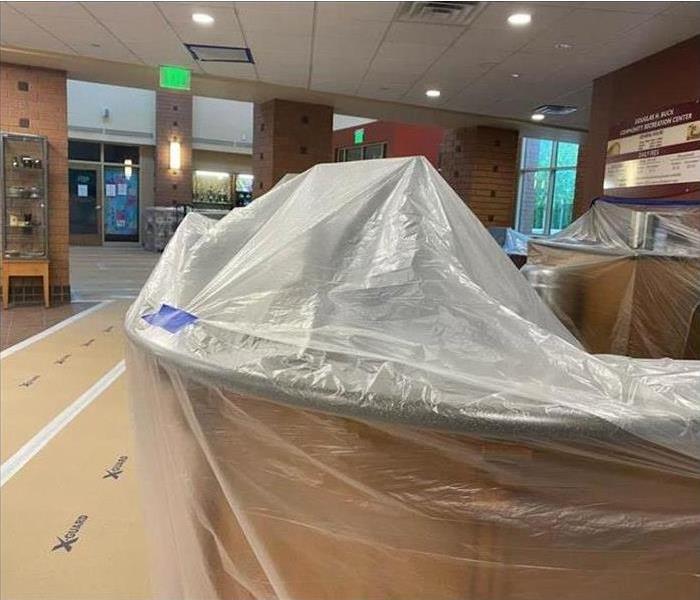 Fire restoration in Acequia, CO.
Fire restoration in Acequia, CO.
Three Critical Steps to Take If Your Business Is Affected by a Fire
When your business in Acequia, CO is damaged by a fire, you may not know what you should do next. Knowing what steps you should take after a fire can help you quicken the fire restoration process and can also help alleviate stress as you restore your building.
1. Know Your Financial Responsibility
After your business has been damaged by a fire, you may be eager to begin the process of cleaning and restoring your building. However, it’s often important to understand what costs you as a business owner will be responsible for and what insurance will cover. Generally, your fire insurance should cover the costs of property loss, business interruption and smoke cleaning.
2. Protect Your Business
Once you know what costs will be covered and what damage you may need to pay for, preventing any more damage from occurring can be an important next step to take. Board up services are often used to keep buildings safe before fire restoration can begin. Boarding up your building can prevent wind and rain from causing further damage to your building and can also help to deter thieves from entering your business.
3. Restore Your Building
The process of restoring your business is often multifaceted. Depending on the areas in your building that were affected by the fire, your business may need some structures to be repaired or replaced. Even if structural replacements aren’t necessary, it’s important that smoke odor and soot are removed from the building. Every surface in your business that has been affected by the fire will be thoroughly sanitized, and items that were damaged will either be restored or replaced.
Understanding the steps to take after a fire can help you feel more confident and prepared for the restoration process. If your business has been damaged by a fire, it might be useful to work with experts in fire restoration and cleanup.


 24/7 Emergency Service
24/7 Emergency Service






























